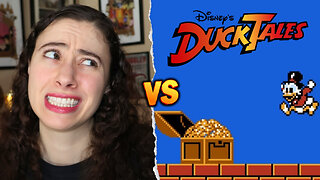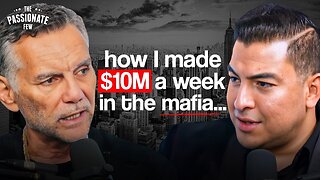Premium Only Content

The LNT Fraud - Second interview with Prof. Edward Calabrese
Second interview with Edward J Calabrese, professor of Toxicology at the Univ. of Massachusetts Amherst regarding the recent development in his investigation of what's known as the LNT Fraud. You can find our first interview with more related documentation at https://youtu.be/3-mkhPvi-xU
Questions:
1) we read that in 2015 you wrote to "Science" magazine a very detailed letter citing the fraudolent behavior of the BEIR and BEAR committees. Can you tell us about it and whether there have been consequences? [00:33]
http://atomicinsights.com/edward-calabrese-challenges-science-magazine-to-right-a-59-year-old-case-of-scientific-misconduct/
(Rod Adams - https://www.youtube.com/user/atomicrod59)
2) Please tell us about the origins and the objectives of the hormesis theory and its difference wrt the LNT model? [14:57]
3) can you tell us about the hormetic database? How do you detect memory improvements in a mouse and can you tell us about the possibility of tests on humans? [27:17]
4) Please explain us the mechanisms leading to an improvement of the organism by means of a hormetic dose response [39:52]
5) Can you tell us what kind of substances are used to test the hormetic dose/response and the criteria used to choose them? [45:11]
6) In your 2015 article "Model uncertainty..." you write "ionizing radiation was shown to significantly enhance the lifespan of the insect model, the confused flour beetle, in an extremely well-designed study that has been repeatedly confirmed". Can you please tell us some details about this experiment and its outcome? (i.e. radioisotopes used, radiation exposition time of the insects, extension of the conclusions to humans) [49:15]
7) in your 2013 paper "hormetic mechanisms" you list two types of agents: endogenous agents and agonists. Can you please tell us the differences? [01:08:25]
8) what could the future implications of the adoption of the hormetic model? [01:12:11]
9) Which do you the think the reasons are to still be stuck in the LNT model? [01:16:50]
10) what are the goals of the research in this field? [01:19:23]
11) you were talking about extensive research on the adaptive responses to ionizing radiation conducted in Japan. Was this a result of what happened in 2011 in Fukushima or was it totally independent? [01:24:33]
12) how could humanity benefit from exposure to ionizing radiations conform to the hormetic model? [01:26:07]
13) which radioisotope do you think to be more indicated in order to pursue the objectives you mentioned in your previous answer? [01:30:58]
Related documents:
- Edward J. Calabrese: "Hormetic mechanisms", https://drive.google.com/open?id=0B85aswYLmY0waUhzbU5JbGNtRUk
- Edward J. Calabrese: "On the origins of the linear no-threshold (LNT) dogma by means of untruths, artful dodges and blind faith", [ https://drive.google.com/open?id=0B85aswYLmY0wY3NkME0xejNMMmc ]
- Edward J. Calabrese: "Model Uncertainty via the Integration of Hormesis and LNT as the Default in Cancer Risk Assessment" [ https://drive.google.com/open?id=0B85aswYLmY0wVGFEdXpmMUZjOG8 ]
- Edward J. Calabrese, Dima Yazji Shamoun, Jaap C. Hanekamp: "Cancer risk assessment: Optimizing human health through linear
dose–response models" [ https://drive.google.com/open?id=0B85aswYLmY0wa1RMaG9sWGJ2QWc ]
- Edward J. Calabrese, Robyn B. Blain: "The hormesis database: The occurrence of hormetic dose responses in the toxicological literature" [ https://drive.google.com/open?id=0B85aswYLmY0wYk1vS19RMnUzWjg ]
- Edward J. Calabrese "Flaws in the LNT single-hit model for cancer risk: An historical assessment" [ https://drive.google.com/open?id=0B85aswYLmY0wTXBpcmhYd0h6U0U ]
-
 7:50
7:50
dsmith6875
5 years ago $10.06 earnedElection Fraud interview
9.65K32 -
 31:55
31:55
ZeeeMedia
18 hours agoHow Gold & Silver Fight Against Digital ID ft. Bill Armour | Daily Pulse Ep 148
7.26K8 -
 13:29
13:29
Clintonjaws
15 hours ago $15.01 earnedCNN Host Stops Show & Plays Surprise Clip Forcing Democrat To Correct Lie
31.5K24 -
 14:55
14:55
World2Briggs
19 hours ago $1.91 earnedThe 10 U.S. Cities Americans Can No Longer Afford — 2025 Edition
9.91K -
 8:19
8:19
Millionaire Mentor
17 hours agoATC Whistleblower EXPOSES Obama’s Dirty FAA Secret
13.4K8 -
 2:05:30
2:05:30
BEK TV
1 day agoTrent Loos in the Morning - 11/21/2025
12.1K1 -
 LIVE
LIVE
The Bubba Army
23 hours agoCHICAGO SUBWAY FIRE ATTACK - Bubba the Love Sponge® Show | 11/21/25
1,378 watching -
 57:31
57:31
Side Scrollers Podcast
18 hours agoBlabs VS DuckTales
12.9K10 -
 8:52
8:52
MetatronGaming
15 hours agoOverwatch 2 New Hero Vendetta La Lupa
116K11 -
 1:37:16
1:37:16
omarelattar
23 hours agoEx-Mafia Boss: I Made $8 Million Every Week Until The FBI Destroyed My Life! What I Learned...
28.7K2